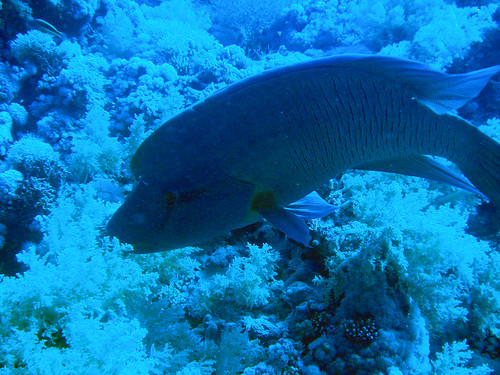Destinations,
Humphead wrasse, Shark Observatory, Ras Mohammad, Egypt
Humphead wrasse
The humphead wrasse (Cheilinus undulatus) is a wrasse that is mainly found in coral reefs in the Indo-Pacific region. It is also known as the Maori wrasse, Napoleon wrasse, Napoleonfish; or "So Mei" (Cantonese) and "Mameng" (Filipino).
The humphead wrasse is the largest living member of the family Labridae, with males reaching 6 feet (2 m) in length, while females rarely exceed about 3 feet (1 m). It has thick, fleshy lips and a hump that forms on its head above the eyes, becoming more prominent as the fish ages. Males range from a bright electric blue to green, a purplish blue, or a relatively dull blue/green. Juveniles and females are red-orange above, and red-orange to white below. Some males grow very large, with one unconfirmed report of a Humphead Wrasse that was 7.75 feet (2.29 m) long and weighed 420 lbs (190.5 kg).
Shark Observatory
The site stretches from the foot of the observatory cliff in the north, across the mouth of a shallow box-shaped inlet, to the beginning of the Anemone City in the south. There are two possible shore entry points, one inside the inlet and the second in the small cove at the foot of the cliff. Both can be reached by road.
In the past, it was possible to see sharks here just by looking down from the cliff top but with the advent of dive tourism and its attendant boat traffic, the sharks have mostly moved on.
The site is a vertical wall, sloping outwards at its foot. The rugged profile is most dramatic in the northern section, where the reef face is especially contoured, with fissures, inlets and crevices to explore. Coral growth is good with lots of variety among both soft and stony species.
The steep profile does not encourage dense populations of smaller reef species, so quality and quantity of fish are somewhat dependent on currents and the pelagic life they encourage. Jacks, barracuda and the occasional gray or blacktip shark liven things up when the current is running: snapper, surgeons and unicorns are present in schools of varying size, and larger reef fish such as big grouper and Napoleons are usually on hand.
Divers should be careful of the strong currents which are common in this area and those who enter from shore should be doubly cautious. Once beyond the point to the north, there is no shore exit point. Do not round the point if current could prevent you from returning to the exit point.
Ras Mohammed is the National Park of South Sinai and located on the very tip of the Sinai Peninsula; it probably represents some of the most famous dive sites in the Red Sea with 800-metre (2,600 ft) deep reef walls and pounding current and coral gardens.



















0 comments: